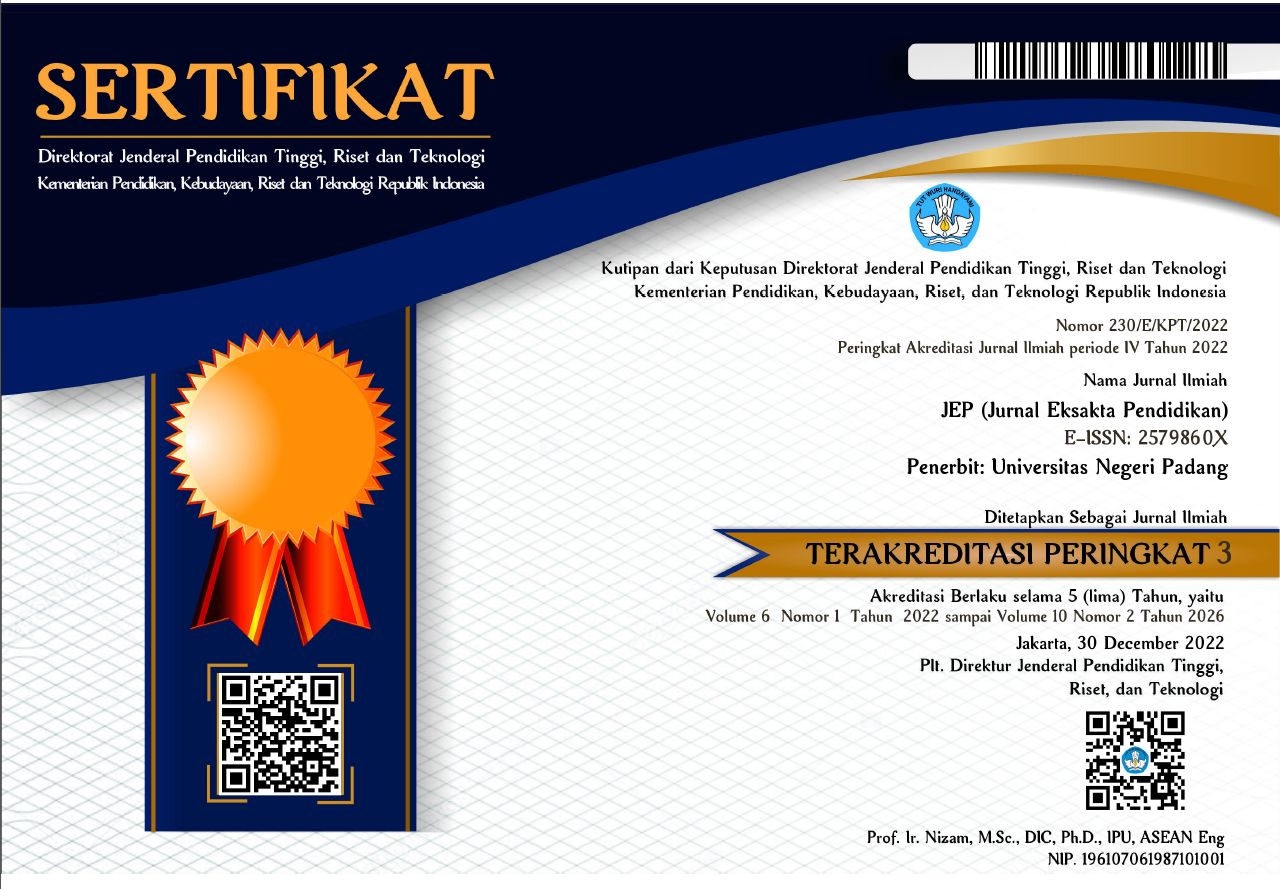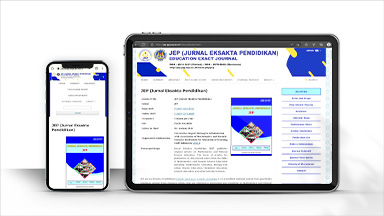Pengembangan Lembar Kerja Peserta Didik Fisika Berbasis Pendekatan Science, Technology, Engineering, and Mathematics untuk Meningkatkan Berpikir Kritis Peserta Didik
Abstract
Students' critical thinking skills are still not optimal. One of the reasons is the use of teaching materials in the form of student worksheets that are not yet in line with the good student worksheet structure, do not yet contain the STEM approach, and critical thinking indicators have not been clearly illustrated in the student worksheet. The purpose of this study is to determine the validity of the LKPD, determine the practicality and effectiveness of using student worksheet Physics based on the STEM approach that can improve students' critical thinking. This type of research is research and development (R&D) using the Borg & Gall model which consists of the initial research and information gathering stage, planning, developing the initial product format, and initial trials. As the object of research is the Physics student worksheet based on the STEM approach. Data collection instruments used were expert validation sheets, practicality test sheets, and effectiveness test sheets. The effectiveness test uses an assessment sheet of learning outcomes tests and observation sheets of students' critical thinking. The data analysis technique used is the analysis of the validity of the Physics student worksheet, the practicality analysis of the use of the Physics student worksheet, and the effectiveness analysis of the use of the Physics student worksheet. Based on the analysis of the data that has been done, two research results can be put forward. First, the average value of the validity of the Physics student worksheet based on the STEM approach is 0.88 and this value is included in the valid category. Second, the average value of the practicality test for the use of Physics student worksheet by teachers and students respectively 91.44 and 84.14. This value shows the Physics student worksheet is in the category of very practical. Besides that, the use of Physics student worksheet based on the STEM approach is effective to improve students' critical thinking
Downloads
References
Beers, S. (2011). 21st Century Skills : Preparing Students for Their Future. Diambil dari: http://www.yinghuaacademy.org/wpcontent/uploads/2014/10/21stcenturyskills.pdf
Borg, W.R., & Gall, M.D. Gall. (1989). Educational Research: An Introduction, Fifth Edition. New York: Longman.
Depdiknas. 2008. Panduan Pengembangan Bahan Ajar. Jakarta: Depdiknas.
Dewi, M., Kaniawati, I., & Suwarma, I.R. (2018), Penerapan Pembelajaran Fisika Menggunakan Pendekatan STEM untuk Meningkatkan Kemampuan Memecahkan Masalah Siswa pada Materi Listrik Dinamis, Seminar Nasional Quantum #25. 381-385.
Emzir. (2010). Metodologi Penelitian Pendidikan : Kuantitatif dan Kualitatif. Depok: PT. Raja Grafindo Persada.
Farwati, R., Permanasari, A., Firman, H., & Suhery, T. (2017). Integrasi Problem Based Learning dalam STEM Education Berorien tasi pada Aktualisasi Literasi Lingkungan dan Kreativitas. Prosiding Seminar Nasional Pendidikan IPA 2017. 198-206.
Hake, R.R. (1998). Interactive Engagement Versus Traditional Methods: A Six-thousand-student Survey of Mechanics Test Data for Introductory Physics Courses, American Journal of Physics. 66, 64–74.
Han, S., Capraro, R. & Capraro, M. M. (2014). How Science, Technology, Engineering, and Mathematics (STEM) Project-Based Learning (PBL) Affects High, Middle, and Low Achievers Differently: The Impact of Student Factors on Achievement. International Journal of Science and Mathematics Education, 13(5). 1089–1113.
Ismail, I., Permanasari, A., & Setiawan, W., (2016), Efektivitas Virtual Lab Berbasis STEM dalam Meningkatkan Literasi Sains Siswa dengan Perbedaan Gender, Jurnal Inovasi Pendidikan IPA, 2(2). 190 – 201.
Ismayani, A., (2016). Pengaruh Penerapan STEM Project-Based Learning Terhadap Kreativitas Matematis Siswa SMK, Indonesian Digital Journal of Mathematics and Education. 3(4). 264-272.
Khoiriyah, N,, Abdurrahman., & Wahyudi, I., (2018). Implementasi Pendekatan Pembelajaran STEM untuk Meningkatkan Kemampuan Berpikir Kritis Siswa SMA pada Materi Gelombang Bunyi. Jurnal Riset dan Kajian Pendidikan Fisika, 5(2). 53-62.
Kuenzi, J., (2008). Science, Technology, Engineering, and Mathematics (STEM) Education: Background, Federal Policy, and Legislative Action. Congressional Research Service Reports. 35. Diambil dari: https:// digitalcommons.unl.edu/crsdocs/35
Mayasari, T., Kadarohman, A., & Rusdiana, D. (2014). Pengaruh Pembelajaran Terintegrasi Science, Technology, Engineering, And Mathematics (STEM) Pada Hasil Belajar Peserta Didik: Studi Meta Analisis. Prosiding Semnas Pensa VI. 371-377.
Redhana, I.W, (2010), Pengaruh Model Pembe lajaran Berbasis Peta Argumen Terhadap Keterampilan Berpikir Kritis Siswa pada Topik Laju Reaksi. Jurnal Pendidikan dan Pengajaran, 43(17). 141-148.
Republika, 2018. Mendikbud Ungkap Cara Hadapi Revolusi 4.0 di Pendidikan. Diambil dari: https://www.republika.co.id/berita/pen didikan/eduaction/18/05/02/p8388c430-mendikbud-ungkap-cara-hadapi-revolusi-40-di-pendidikan.
Runco, M.A., Millar,G., Acar, S. & Gramond, B (2010). Torrance Tests of Creative Thinking as Predictors of Personal and Public Achieve ment: A Fifty-Year Follow-up. Creativity Research Journal, 22(4), 361–368.
Rustaman, N.Y. (2016). Pembelajaran Sains Masa Depan Berbasis STEM Education. Prosiding Seminar Nasional Biologi Edu kasi 2016. Universitas Pendidikan Indonesia
Sari, Y.S., Selisne, M., & Ramli, R. (2019). Role of Students Worksheet in STEM Approach to Achieve Competence of Physics Learning. Journal of Physics: Conference Series. 1185. 012096.
Sugiyono. (2012). Metode Penelitian Kuantitatif, Kualitatif, dan R & D. Bandung: Afabeta.
Sukmadinata, N. S. (2009). Metode Penelitian Pendidikan. Bandung: Rosda Karya.
Sukmana, R.W. (2017), Pendekatan Science, Technology, Engineering and Mathematics (STEM) Sebagai Alternatif dalam Mengembangkan Minat Belajar Peserta Didik Sekolah Dasar. Pendas: Jurnal Ilmiah Pendidikan Dasar, 2(2). 189 – 197.
Copyright (c) 2020 Ramli Ramli, Yohandri Yohandri, Yulis Septianas Sari, Mitri Selisne

This work is licensed under a Creative Commons Attribution 4.0 International License.

This work is licensed under a Creative Commons Attribution 4.0 International License.




_(2579-860X).png)
_(2614-1221)1.png)




